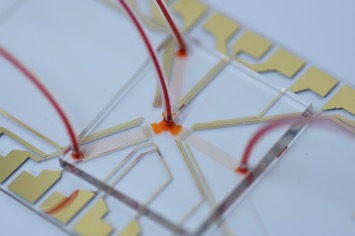An innovative approach to cell analysis, this technology is a high-throughput microfluidic device that efficiently measures cell deformability. Most importantly, its designed to overcome the challenge of low throughput often seen in current cell mechanics assessment systems. It does this with multiple parallel channels that each feature a constriction zone with sensors to measure the transit time for cells moving through the channels. As a cell compresses to enter a constriction zones, the flow through that channel is reduced to near zero. In this device, the open parallel channels can receive other incoming cells so as to minimize idle sensor time and clogging.
As the cells move through the constriction zones, their transit time as compared to other cells can be used as an indicator of their type and/or state. This Georgia Tech innovation can also be scaled to achieve an even greater throughput volume, with the sensors of each additional branch of channels operating at a unique excitation frequency. This allows for true frequency channelization and separate data streams that can be recorded for subsequent analysis.
- High throughput: Addresses the low-throughput challenges of other similar technologies by handling a sample volume near that of a Coulter counter
- Low cost: Eliminates the need for costly equipment, highly trained personnel, and long processing times that come with other measuring processes
- Scalable: Uses a frequency division scheme so that multiple copies of the system can operate concurrently
- Health care diagnostics and therapeutics
- Life sciences research
- Cell manufacturing
- Biotechnology
- Environmental monitoring
- Particle characterization
As cells experience physiological and pathological events, their mechanical properties change, and these changes can inform clinical decisions about diagnoses and treatments. For example, blood cell pathologies such as malaria and sickle-cell disease can be detected by measuring the deformability of cells, as can the metastatic potential of tumor cells. This process of evaluating the mechanical properties of cells is called mechanophenotyping. Many current systems for cell mechanophenotyping are challenged by low-throughput volumes, the need for specially trained operators, and high overhead costs—all of which make them impractical in clinical settings. This Georgia Tech innovation is a microfluidic-based solution for measuring cell deformability that optimizes the evaluation of cells of interest, resulting in highly accurate data at a reasonable cost.
To see more technologies by Dr. Sarioglu and his team, please click here.

Photograph of the device, with red dye introduced to highlight the fluidic pathways

A 3D illustration of the microfluidic channels, featuring the constriction zones, cells, and sensors
